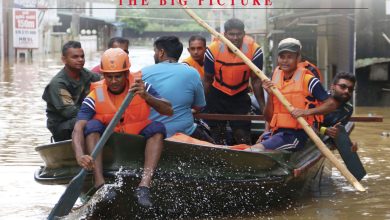MARITIME PROSPECTS
BLUE ECONOMY IN ALL ITS GLORY
Zulfath Saheed highlights measures to safeguard Sri Lanka’s precious marine resources

The ocean is a marvellous body inhabited by an array of flora and fauna, some of which are not even known to humankind. It was only a month or so ago that the BBC Natural History Unit’s Blue Planet II series – narrated and presented by Sir David Attenborough – explored and revealed new worlds and animal behaviours throughout the Earth’s oceans.
Here in Sri Lanka, we often take it for granted that an abundance of ocean resources is at our disposal. As an island nation, fishing and related occupations have provided a livelihood to countless citizens.
Meanwhile, the more recent resurgence in tourism has seen foreign visitors flock to local beaches in search of sun, sea and sand. But in the present day and age, there is also an increased focus on the sustainable use of resources – whether they’re from the land or seas.
Therefore, the onus is on nations such as Sri Lanka to protect ocean resources so that future generations can benefit from them as well.

MARINE RESOURCES The Indian Ocean, which borders Sri Lanka, is thought to account for the second largest share of the most economically valuable tuna catch. This is of growing importance for both domestic consumption and export. However, it is reported that tuna catch rates have declined in the past half-century primarily due to increased industrial fisheries while ocean warming has added further stress to the
fish species.
With over 80 percent of global seaborne trade in oil transiting through them, the sea lanes in the Indian Ocean are considered to be among the most strategically important in the world. Furthermore, an estimated 40 percent of the world’s offshore oil production comes from the Indian Ocean.
MAJOR CHALLENGES Representing Sri Lanka at the UN Conference to Support the Implementation of Sustainable Development Goal (SDG) 14, Manjula Amararathne – Director (Operations and Nature Resource Management) of the Department of Wildlife Conservation – identified the major threats to the healthy biodiversity and productivity of marine and coastal ecosystems as resulting from “various human activities such as garbage dumping, illegal fishing methods, over-extraction of coastal and marine resources, and illegal occupation of lands.”
He also noted that “uncontrolled measures such as the increase of seawater temperature” had destroyed much of the coral reefs in Sri Lanka.”
OCEAN REGULATION Legal provisions to sustainably manage the fisheries resources of Sri Lanka are provided by the Fisheries and Aquatic Resources Act 1996 and its amendments. Moreover, Sri Lanka is party to the United Nations Convention on the Law of the Sea and ratified the convention in 1994. It is also committed to the sustainable use of marine resources, and the conservation and management of fish stocks.
Meanwhile, the Marine Environment Protection Authority is the apex body established by the Government of Sri Lanka (under the Marine Pollution Prevention Act No. 35 of 2008) with the sole responsibility to prevent, control and manage the pollution of the marine environment.
SUSTAINABILITY AGENDA As part of its commitment to SDG 14 on Life Below Water, Sri Lanka seeks to conserve and sustainably use the oceans, seas and marine resources for sustainable development.
To this end, its areas of focus include preventing and significantly reducing marine pollution of all kinds, in particular from land based activities such as marine debris and nutrient pollution, by 2025; and sustainably managing and protecting marine and coastal ecosystems to avoid significant adverse impacts by strengthening their resilience, and taking action for their restoration to achieve healthy and productive oceans by 2020.
MAN-MADE DISASTER The use of plastics has proved to be an issue on multiple fronts of the sustainability agenda and the protection of ocean resources has also highlighted the need for stronger action in this regard.
Closer to home, the ‘Indian Ocean garbage patch’ – a vortex of plastic garbage – was discovered in 2010. It constitutes an elevated level of pelagic plastics, chemical sludge and other debris.
According to an investigation conducted by The Guardian, “consumers around the world buy a million plastic bottles a minute. Plastic production is set to double in the next 20 years and quadruple by 2050. Around the world, more than eight million tonnes of plastic leaks into the oceans and a recent study found that billions of people globally are drinking water contaminated by plastic.”
Attenborough, who is a renowned naturalist, also reportedly stated: “What we’re going to do about 1.5 degrees rise in the temperature of the ocean over the next 10 years I don’t know but we could actually do something about plastic right now … There are so many sequences that every single one of us has been involved in – even in the most peripheral way – where we have seen tragedies happen because of the plastic in the ocean.”







For Sri Lanka, the ocean is a treasure of resources. It is ungrateful to consider it as the ultimate outlet, or as a can of trash for waste disposal. The country’s surrounding ocean is mainly exploited for fish and also supports the tourism industry with its natural beauty. Many varieties of mineral sands with substantial export value and potential mining areas are also part of this valuable coastal line – the latter is yet to be tapped, considering its potential.
The tourism industry has a collective responsibility, where all players – large, small, formal and informal – should preserve the surrounding environment in coastal areas. Many valuable animal species such as sea turtles have been exploited and illegally traded by beach-trespassers for quick gains.
It is the responsibility of the Ministry of Fisheries and Aquatic Resources to ensure that illegal fishing methods are avoided and that perpetrators are duly handled with enforceable laws. Furthermore, the ministry needs to play a big role in redefining its policies, and monitoring and reviewing strategies to protect the marine and biological resources of Sri Lankan seas.
The environmental authority perhaps with the municipal and urban councils can collaborate and ensure that sewage is treated prior to disposing it to sea. This will minimise possible harm to marine animals and plants. Many beach areas have been destroyed carelessly due owing to the sheer enjoyment of humans who patronise the beach, and litter it with empty liquor bottles.
The public too has a duty to utilise the beach without polluting the water, sand and plants that grow in coastal areas.
SDG’s should have been more specific and clear as to how oceans, seas and marine resources can be conserved for sustainable development.